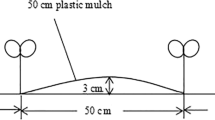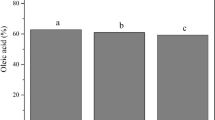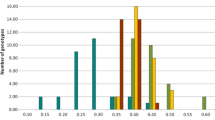Abstract
Both transplanting and direct-sowing are the dominated methods for establishing winter oilseed rape in China. It is important to understand crop performances and responses to nutrient deficiency between transplanted oilseed rape (TOR) and direct sown oilseed rape (DOR). We estimated the effects of establishment methods (transplanting and direct-sowing) and nutrient deficiency (N, P, and K) on rapeseed yield, yield components, and nutrient uptake from 32 site-years field experiments. We found that DOR plants produced lower seed yield, dry matter, and harvest index than TOR plants. The population density in DOR was higher with poor individual growth as reflected by significantly reduced branches, pods, and seeds pod−1. Thus, DOR plants were more sensitive to nutrient deficiency and would lose more yield under nutrient omission conditions. TOR and DOR yields significantly correlated with all yield components except for 1000-seed weight. Pod number plant−1 showed the strongest direct effect on TOR yield. However, population density and pod number plant−1 exhibited highest direct effect on DOR yield. The uptakes and harvest indexes of N and P were higher for TOR, while the DOR plots received higher K uptake and harvest index of K. DOR was more sensitive to nutrient deficiency and its nutrient management should be paid more attention.







Similar content being viewed by others
Abbreviations
- DOR:
-
Direct sown winter oilseed rape
- TOR:
-
Transplanted winter oilseed rape
- DHI:
-
Dry matter harvest index
- YRB:
-
Yangtze River Basin
References
Ali, N., Javidfar, F., Elmira, J., & Mirza, M. Y. (2003). Relationship among yield components and selection criteria for yield improvement in winter rapeseed. Pakistan Journal of Botany,35(2), 167–174.
Amanullah, Hassan, M., & Malhi, S. S. (2011). Seed yield and yield components response of rape (B. napus) versus mustard (B. juncea) to sulfur and potassium fertilizer application in northwest Pakistan. Journal of Plant Nutrition,34(8), 1164–1174. https://doi.org/10.1080/01904167.2011.558159.
Biswas, M., Islam, N., Islam, S., & Ahmen, M. (2009). Seedling raising method for production of transplanted maize. International Journal of Sustainable Crop Production,4(2), 6–13.
CAY. (2013). China agriculture yearbook. Beijing: Chinese Agricultural Press.
Ciampitti, I. A., Camberato, J. J., Murrell, S. T., & Vyn, T. J. (2013). Maize nutrient accumulation and partitioning in response to plant density and nitrogen rate: I. Macronutrients. Agronomy Journal,105(3), 783–795. https://doi.org/10.2134/agronj2012.0467.
Cui, Z., Zhang, F., Chen, X., Miao, Y., Li, J., Shi, L., et al. (2008). On-farm evaluation of an in-season nitrogen management strategy based on soil Nmin test. Field Crops Research,105(1–2), 48–55. https://doi.org/10.1016/j.fcr.2007.07.008.
Diepenbrock, W. (2000). Yield analysis of winter oilseed rape (Brassica napus L.): a review. Field Crops Research,67(1), 35–49. https://doi.org/10.1016/s0378-4290(00)00082-4.
Dong, H. Z., Li, W. J., Tang, W., Li, Z. H., & Zhang, D. M. (2005). Increased yield and revenue with a seedling transplanting system for hybrid seed production in Bt cotton. Journal of Agronomy and Crop Science,191(2), 116–124. https://doi.org/10.1111/j.1439-037X.2004.00130.x.
Fanadzo, M., Chiduza, C., & Mnkeni, P. N. S. (2009). Comparative response of direct seeded and transplanted maize (Zea mays L.) to nitrogen fertilization at Zanyokwe irrigation scheme, Eastern Cape, South Africa. African Journal of Agricultural Research,4(8), 689–694.
FAO. (2017). FAOSTAT Database. http://faostat.fao.org/site/339/default.aspx. Accessed 10 Apr 2019.
Farooq, M., Siddique, K. H. M., Rehman, H., Aziz, T., Lee, D.-J., & Wahid, A. (2011). Rice direct seeding: Experiences, challenges and opportunities. Soil and Tillage Research,111(2), 87–98. https://doi.org/10.1016/j.still.2010.10.008.
Hocking, P. J., Randall, P. J., & DeMarco, D. (1997). The response of dryland canola to nitrogen fertilizer: partitioning and mobilization of dry matter and nitrogen, and nitrogen effects on yield components. Field Crops Research,54(2–3), 201–220. https://doi.org/10.1016/S0378-4290(97)00049-X.
Hocking, P. J., & Stapper, M. (2001). Effects of sowing time and nitrogen fertiliser on canola and wheat, and nitrogen fertiliser on Indian mustard. II. Nitrogen concentrations, N accumulation, and N fertiliser use efficiency. Australian Journal of Agricultural Research,52(6), 635–644. https://doi.org/10.1071/ar00114.
Horwitz, W., & Latimer, G. W., Jr. (1970). Official methods to analysis (Vol. 11th, pp. 17–18). Washington, DC: AOAC.
Islam, N., & Evans, E. J. (1994). Influence of lodging and nitrogen rate on the yield and yield attributes of oilseed rape (Brassica napus L.). Theoretical And Applied Genetics,88(5), 530–534. https://doi.org/10.1007/bf01240914.
Li, Y. Y., Wang, Y., & Lu, J. W. (2012). Effect of phosphorus fertilization on yield and phosphorus use efficiency of winter oilseed rape (Brassica napus L.) with two different cropping intensities in the middle and lower reaches of Yangtze River. Journal of Food, Agriculture and Environment,10(2), 576–579.
Liu, H., Hu, C., Sun, X., Tan, Q., & Nie, Z. (2012). Interactive effects of molybdenum and phosphorus fertilizers on dry matter accumulation, seed yield and yield components in Brassica napus. Journal of Food, Agriculture and Environment,10(3–4), 389–392.
Liu, T., Ren, T., White, P. J., Cong, R. H., & Lu, J. W. (2018). Storage nitrogen co-ordinates leaf expansion and photosynthetic capacity in winter oilseed rape. Journal of Experimental Botany,69(12), 2995–3007. https://doi.org/10.1093/jxb/ery134.
Liu, Q. X., Ren, T., Zhang, Y. W., Li, X. K., Cong, R. H., White, P. J., et al. (2019). Yield loss of oilseed rape (Brassica napus L.) under nitrogen deficiency is associated with under-regulation of plant population density. European Journal of Agronomy,103, 80–89. https://doi.org/10.1016/j.eja.2018.11.006.
Liu, S., Zhang, Y., Lin, F., Zhang, L., & Zou, J. (2014). Methane and nitrous oxide emissions from direct-seeded and seedling-transplanted rice paddies in southeast China. Plant and Soil,374(1–2), 285–297. https://doi.org/10.1007/s11104-013-1878-7.
Lu, J. W. (2010). Scientific fertilization technology for oilseed rape (in Chinese). Beijing: God Shield Press.
Marjanović-Jeromela, A., Marinković, R., Mijić, A., Zdunić, Z., Ivanovska, S., & Jankulovska, M. (2008). Correlation and path analysis of quantitative traits in winter rapeseed (Brassica napus L.). Agriculturae Conspectus Scientificus,73(1), 13–18.
Ozer, H. (2003). Sowing date and nitrogen rate effects on growth, yield and yield components of two summer rapeseed cultivars. European Journal of Agronomy,19(3), 453–463. https://doi.org/10.1016/s1161-0301(02)00136-3.
Ozer, H., Oral, E., & Dogru, U. (1999). Relationships between yield and yield components on currently improved spring rapeseed cultivars. Turkish Journal of Agriculture and Forestry,23, 603–608.
Rajakumar, D., Gurumurthy, S., Pandian, B., & Thiyagarajan, G. (2010). Population dynamics and nutrient spray on the yield and economics of direct sown and transplanted hybrid cotton Tchb 213. Indian Journal of Agricultural Research,44(3), 206–210.
Singh, Y., Singh, V. P., Singh, G., Yadav, D. S., Sinha, R. K. P., Johnson, D. E., et al. (2011). The implications of land preparation, crop establishment method and weed management on rice yield variation in the rice–wheat system in the Indo-Gangetic plains. Field Crops Research,121(1), 64–74. https://doi.org/10.1016/j.fcr.2010.11.012.
Sparks, D. L., Page, A., Helmke, P., Loeppert, R., Soltanpour, P., Tabatabai, M., et al. (1996). Methods of soil analysis. Part 3. Chemical methods. Madison: Soil Science Society of America Inc.
Walinga, I., Lee, J. J. V. D., Houba, V. J. G., Vark, W. V., & Novozamsky, I. (1995). Plant analysis manual (p. 272). Dordrecht: Kluwer Academic Publishers.
Wang, Y., Lu, J. W., Li, X. K., Li, J. F., Liu, P. P., Xu, W. M., et al. (2011). Study on nitrogen fertilizer effect and optimum fertilizer rate for transplanting and direct-seeding rapeseed (in Chinese). Scientia Agricultura Sinica,44(21), 4406–4414. https://doi.org/10.3864/j.issn.0578-1752.2011.21.009.
Wang, Y., Lu, J. W., Li, X. K., Liu, B., Yuan, F. S., & Xiao, Z. Q. (2012a). Effects of fertilizers application on growth, seed yield, NPK absorption and accumulation of direct-seeding rapeseed in red soil (in Chinese). Soil and Fertilizer Sciences in China, (01), 38–42, 52.
Wang, Y., Li, X. K., Li, Y. Y., Li, J. F., Xiao, G. B., Zheng, W., et al. (2012b). Responses of direct-seeding rapeseed to fertilization in fields of red soil different in fertility (in Chinese). Acta Pedologica Sinica, 49(01), 121–129.
Wang, Y., Lu, J. W., Li, X. K., Ren, T., Cong, R. H., & Zhan, L. P. (2013). Effects of nitrogen, phosphorus, potassium, and boron fertilizers on winter oilseed rape (Brassica napus L.) direct-sown in the Yangtze River basin (in Chinese). Acta Agronomica Sinica,39(8), 1491–1500.
Xin, N. Q., & Tong, P. Y. (1986). Multiple cropping system and it’s development orientation in China (A review) (in Chinese). Scientia Agricultura Sinica,19(4), 88–92.
Zhang, C. L., Li, J., Yu, L. P., Li, F., & Ma, N. (2010). Input/output analysis on rapeseed production practices under different cultivation mode (in Chinese). Chinese Journal of Oil Crop Sciences,32(1), 57–64.
Zhang, Z., Lu, J. W., Cong, R. H., Ren, T., & Li, X. K. (2018). Evaluating agroclimatic constraints and yield gaps for winter oilseed rape (Brassica napus L)—A case study). Scientific Reports. https://doi.org/10.1038/s41598-018-20636-2. (Artn 2746).
Zou, J., Lu, J. W., Chen, F., & Li, Y. S. (2009). Effect of nitrogen, phosphorus, potassium, and boron fertilizers on yield and profit of rapeseed (Brassica napus L.) in the yangtze river basin (in Chinese). Acta Agronomica Sinica,35(1), 87–92. https://doi.org/10.3724/sp.j.1006.2009.00087.
Zou, J., Lu, J. W., Li, Y. S., Li, Z. Y., & Chen, F. (2008). Study on the effects of NPK fertilizers and optimum fertilizer rate on direct-seeding rapeseed (In Chinese). Chinese Journal of Oil Crop Sciences, 30(1), 90–94.
Acknowledgements
This study was supported by National Key Research and Development Program of China (2018YFD0200908), the Earmarked Fund for China Agriculture Research System (CARS-12), the Fundamental Research Funds for the Central Universities (2662017JC010), and International Plant Nutrition Institute Co-operation Program (Hubei-35). We are grateful to Yanhong Lu, Yongchun Zhang, Lina Jiang, Fusheng Yuan, and Ji Wu for their excellent supports in conducting the on-farm experiments. There is no conflict of interest in the manuscript.
Author information
Authors and Affiliations
Corresponding author
Rights and permissions
About this article
Cite this article
Cong, R., Wang, Y., Li, X. et al. Differential Responses of Seed Yield and Yield Components to Nutrient Deficiency Between Direct Sown and Transplanted Winter Oilseed Rape. Int. J. Plant Prod. 14, 77–92 (2020). https://doi.org/10.1007/s42106-019-00069-1
Received:
Accepted:
Published:
Issue Date:
DOI: https://doi.org/10.1007/s42106-019-00069-1




